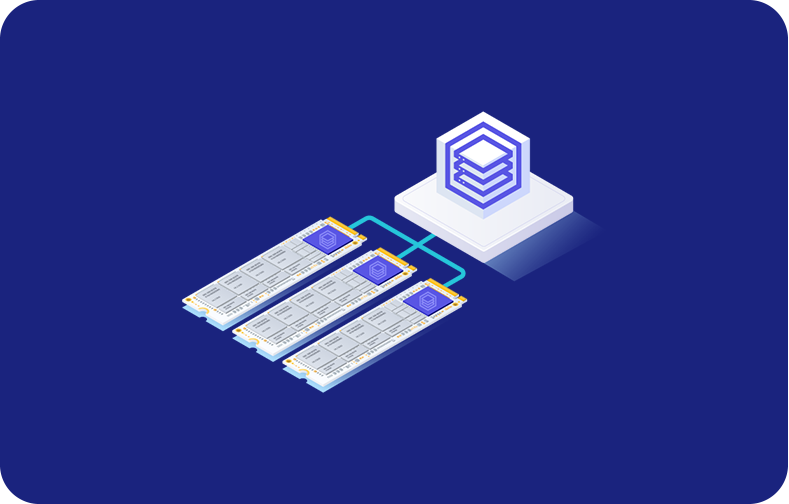Linode VPS

Linode VPS brings the entire cloud computing industry into a new level of revolutionary processes by delivering a fully featured and widely supported service to all applications and services the digital world comprises. Linode offers virtual private server (VPS) hosting, which helps users deploy and control multiple virtual instance servers running within the cloud. This capability is essential for today's web development, app hosting, and service deployment. It puts Linode in a shining position as an inseparable asset for developers, businesses, and IT pros demanding scalable, efficient, and cost-saving cloud solutions.
-
- A Bit About Linode
- History of Linode
- Five Reasons VPSServer superior to Linode VPS
- Why Linode with Cloudways?
- Server & Application Deployment Made Easy for Linode
- How to Deploy a Linode VPS Server
A Bit About Linode
Linode brand has become a leader in the cloud service industry, regularly shaping the future of such services with the most innovative solutions. Linode is a product with a dream of democratizing cloud computing. It created a stable and scalable platform that is still affordable. The cloud closer approach has more users from around the world, including clients, developers, businesses, and hobbyists, because the technology allows them to have the opportunity to use the very concepts in the development of their projects without the limitations of high costs. A core part of Linode's ethos is the empowerment philosophy, which offers user-friendly and high-performance cloud computing services that, in turn, help the users concentrate on creativity and development.
History of Linode
The company was established in the early 2000s’ as cloud computing was still in its early phase. Linode seeks to provide a low-cost alternative to the intricate and costly cloud services available on the market that are hyper-competitive. Its goal is to make clouding easier, and this is the way it does it, managing to be easier but at the same time more apparent than ever. Linode established itself as an innovative company, has grown, and acting on its goal of meeting the client's needs from its inception to its current state as a reliable cloud service provider is backed by the company's present position.
Throughout its evolution, Linode has expanded its infrastructure, establishing data centers across the globe to guarantee optimal performance and reliability, and broadened its service portfolio. Today, Linode's offerings encompass various cloud solutions to meet various needs. It is a renowned provider known for its user-centric approach and contribution to innovation across industries.
This growth mirrors the wider cloud industry's evolution from a niche concept to an integral part of today's digital ecosystem. Delving into Linode's history offers insights into the company's development and a deeper understanding of the cloud computing revolution's impact on our digital lives.
Five Reasons VPSServer superior to Linode VPS

VPSServer.com and Linode have emerged as prominent providers with distinct offerings and capabilities in the competitive cloud service landscape. This analysis, enriched with key industry terminologies, delves into the nuanced advantages of VPSServer.com over Linode, reflecting on their strengths in cloud hosting, infrastructure, and managed service.
1. Affordable Cloud Computing & Cloud Hosting
VPSServer.com stands out for its economic pricing approach to cloud service, offering a compelling alternative to other cloud providers like Linode, Google Cloud, and AWS. Its pricing strategy is designed to accommodate the financial constraints of small businesses and startups, ensuring they can leverage cloud computing without needing a valid credit card for trial pricing.
2. Award-Winning Customer Support & Managed Service
Unlike shared hosting, which often leaves users wanting more support, VPSServer.com offers managed service with 24/7 technical support through a ticketing system. This ensures high availability and quick resolutions to uptime issues, contrasting Linode's service level agreement and support offerings.
3. Powered by Linux
VPSServer.com and Linode offer Linux virtual machines catering to experienced developers and clients requiring stable, secure environments for hosting websites, machine learning applications, or WordPress sites. However, VPSServer.com extends its flexibility by supporting multiple packages for memory-intensive applications, making it a versatile choice for managing multiple server instances.
4. What is VPSServer Powerful API and User Interface
The platform's user-friendly interface and powerful API allow users to manage multiple server instances with just a few clicks, deploy virtual machines, or initiate site migrations effortlessly. This ease of use is a significant advantage over Linode's command-line interface (CLI) and Linode Manager, offering a more accessible resources experience for users not versed in command-line operations.
5. Where is VPSServer’s Data Center
VPSServer.com's data centers and cloud infrastructure span 20+ locations worldwide, including access to high-speed connected cloud, ensuring low latency for cloud servers. This global reach is crucial for businesses aiming to target a multinational corporation audience or store data near their target audience. The platform's commitment to DDoS protection, dedicated CPU options, and high memory specifications for virtual machines and compute instances also underscores its superiority in performance and security over Linode and other cloud providers.
Why Linode with Cloudways?
Choosing Linode VPS with Cloudways is a strategic move for businesses aiming to leverage the best of cloud computing. This collaboration brings together Linode's robust cloud infrastructure and Cloudways' intuitive management platform, offering an unparalleled hosting solution that emphasizes simplicity, power, and reliability. This partnership directly responds to the demand for a more accessible, powerful cloud hosting solution, underscored by positive customer feedback for Linode's efficient and straightforward features.
Linode, known for its scalable hosting solutions, is particularly adept at handling e-commerce and custom applications prone to occasional traffic spikes. Such scalability is crucial for businesses requiring flexibility in their hosting arrangements to accommodate varying levels of web traffic without compromising site performance or incurring unnecessary costs.
Cloudways amplifies Linode's capabilities with an array of enhanced features:
-
ThunderStack and CloudwaysCDN work in tandem to ensure lightning-fast website performance, significantly reducing page load times for a global audience.
-
Automated backups provide peace of mind, safeguarding data against loss and facilitating easy recovery in unforeseen incidents.
-
24x7 technical support ensures that expert help is just a ticket away, ready to assist with any issues that may arise, from server management to site migrations.
-
The Cloudways platform offers over 50+ 1-click features, allowing for the easy management of multiple server instances, application deployment, and much more, all through a user-friendly interface.
Integrating Linode with Cloudways offers businesses a competitive edge, combining Linode's reliable cloud server and DDoS protection with Cloudways' managed service. This synergy allows for deploying Linux virtual machines, managing IP addresses, and utilizing dedicated CPUs for memory-intensive applications, all while ensuring high availability and uptime. Linode's global network of data centers further enhances this offering, providing a solid foundation for hosting applications that cater to a multinational corporation or a niche target audience.
This is the best choice for developers who want VPSs to give advanced performance and small businesses that need a hosting solution with simple management tools. The service provided by the unprecedented combination of Linode's infrastructure and the Cloudways managed service allows one to simplify the procedure that involves creating, deploying, and maintaining the cloud-based applications, therefore making it an excellent choice for those businesses who want to focus on their growth without being distracted by technical complexities.
Choosing Linode with Cloudways means opting for a cloud hosting solution that is affordable, scalable, and backed by comprehensive support and security measures. It represents a strategic partnership designed to meet the diverse needs of modern businesses, ensuring they can leverage cloud service effectively to drive growth and innovation.
Server & Application Deployment Made Easy for Linode

Successfully deployed applications like WordPress and Drupal on Linode VPS through Cloudways, significantly streamlining the process and mitigating the usual complexities of server management. This managed service approach empowers users to focus more on their business operations rather than getting entangled in the technical nuances of backend management. With Linode's cloud server, users are guaranteed a 99.99% uptime, a commitment supported by Cloudways' round-the-clock technical support, ensuring a smooth, uninterrupted service.
The partnership between Linode and Cloudways showcases their dedication to offering a superior managed cloud hosting service, harnessing Linode's advanced cloud computing capabilities to deliver unmatched performance and scalability. This alliance particularly benefits many users - from individual developers and small businesses to large multinational corporations - providing a robust cloud solution that supports site migrations, utilizes dedicated CPU instances, and deploys Linux virtual machines effortlessly.
Linode's infrastructure is a solid foundation for various cloud services, enhancing users' ability to host websites, store data, and deploy applications efficiently. Whether leveraging Linode Backup for unparalleled data security or tapping into Linode's extensive network of data centers for reliable cloud servers, Cloudways' managed service augments the user experience, presenting an all-encompassing cloud hosting solution. This collaboration ensures users can easily navigate site migrations, manage multiple server instances, and utilize Linode's CLI and Linode Manager for seamless operations.
The integration with Akamai's connected cloud and compatibility with other cloud providers like Google Cloud and Digital Ocean further broadens the spectrum of choices for users, allowing them to select the most suitable cloud infrastructure for their specific needs. Linode's VPS solutions, known for their high memory and dedicated CPU capabilities, are designed to cater to memory-intensive applications, ensuring availability and efficiently addressing potential uptime issues.
Cloudways enhances this offering by including features such as a load balancer, DDoS protection, IP address management, and automated backups, all accessible with just a few clicks through the platform. This makes it an invaluable resource for experienced developers and those new to cloud hosting, simplifying the deployment of cloud servers and virtual machines.
Choosing Linode with Cloudways for server & application deployment offers a streamlined, secure, and scalable solution for digital needs. It combines Linode's robust server performance and Cloudways' expertise in managed hosting service, creating a synergy that enhances the deployment, management, and scaling of web applications for businesses of all sizes.
How to Deploy a Linode VPS Server
Deploying a VPS (Virtual Private Server) on Linode will be fun as it will offer you higher control over your web hosting environment. The journey to a successful deployment begins with two essential steps: picking the right option for meeting your needs and setting up your Linode account. These first decisions drive your server’s performance, ensuring your online presence is alive and free from administrative chaos.
Preparing for Deployment
Setting up a Virtual Private Server (VPS) at Linode is a thrilling journey that provides more control over your hosting environment. The journey to a successful deployment begins with two essential steps: choosing the plan that suits your needs and creating your Linode account. These initial decisions lay the foundation for your server’s capabilities, ensuring a smooth start and efficient management of your online presence.
Choosing the Right Plan
The first critical stage in the Linode deployment path is picking a plan that fits your project’s needs. This choice is essential since resources are allocated to your applications and websites. Linode provides various plans targeted toward different requirements, from a single personal project to an application for large-scale enterprises. To make a rational decision, you must assess the project's requirements against the given computing resources, such as CPU performance, memory capacity, storage, and bandwidth. When considering your requirements, consider your immediate needs and long-term development, thus minimizing costs on futile migrations or adjustments. Of course, cost is a significant consideration; however, this value must be understood in terms of reliability, performance, and support and put on an equal footing with cost when making choices.
Setting Up Your Linode Account
Selecting the detailed plan that suits you is the next step after you have chosen your plan following your needs. Navigating through the process is direct and relatively simple to get started. You will start with a simple sign-up on the Linode website, then fill in your email, make a password, and verify your account by clicking on a link sent via email during the signup. This is the critical point, as it establishes the formal partnership with Linode and allows access to the entire range of options and functionalities. Finally, you will verify your account and set up your profile. This will entail selecting a payment method that you are comfortable with. Linode provides different payment methods; hence, everyone can pay according to what fits them best. Furthermore, although optional in the initial phase, using two-factor authentication is highly encouraged for the account’s security, ensuring that only you have the right to manage it.
Choosing the right plan and setting up your Linode account are more than mere administrative tasks; they are strategic decisions that significantly impact the success and security of your server. By carefully considering your needs and securing your account, you set the stage for a smooth deployment process. With these steps completed, you are ready to embark on the next phase of your journey with Linode, equipped with a plan and an account that perfectly matches your project’s needs and aspirations.
Choosing Your Linode Configuration
After that, registering for your Linode account and picking the right plan comes a succession of steps that include selecting the desired Linode configuration. This process is crucial because it will directly affect the server's effectiveness, response time, and performance. Distribution selection is the first important decision in this step and then comes the data center location. Both alternatives should be considered adequately, as they match your project's requirements and objectives.
Selecting a Distribution
Linode supports various Linux distributions, each with unique features, performance characteristics, and community support. Your choice of a distribution will define the software environment for your server. Here are a few considerations to keep in mind when selecting one:
-
Familiarity: While a familiar distribution is no longer as important when you can fall back on tutorials and other documentation, you're still better off with one you know than trying to acclimate yourself to a relative unknown. Not only is there a much shorter learning curve, as you might guess, but you can hit the ground running rather than spending more time (and potentially money) trying to optimize a distro you're not particularly fond of.
-
Software Requirements: Some applications have specific environment requirements that can make one distribution more suitable than another. Research the compatibility and performance of your intended applications with the available distributions to ensure optimal operation.
-
Community and Support: A distribution's community's strength and activity level can be a valuable resource. Distributions with active communities provide extensive documentation, forums, and troubleshooting resources that can be incredibly helpful, especially for those new to server management.
-
Long-Term Support (LTS) Releases: Consider whether the distribution offers Long-Term Support releases. LTS versions receive updates and security patches for extended periods, making them a stable and secure choice for servers prioritizing reliability.
Choosing a Data Center Location
The place of the server that your site is on has an enormous potential impact on your site’s performance, precisely its speed and latency. Linode has numerous data centers worldwide so you can choose the best location for your users. So how should you decide?
-
Proximity to Users: Normally, the latency decreases when the server is nearer to your users. Selecting a data center close to your primary audience will help you ensure a good loading page and, ultimately, a good user experience.
-
Network Performance: Consider the network infrastructure and connectivity of the data center locations. Some regions offer better connectivity and more reliable performance based on the quality of the local internet service providers and the data center's network architecture.
-
Legal and Regulatory Considerations: This will vary widely based on the nature of your application, and there may well be legal or regulatory reasons why you need to host your data in certain jurisdictions, so you must be sure that the data center location complies with laws or rules relating to data sovereignty, privacy, or any other relevant regulations.
-
Redundancy and Backup: Consider deploying across multiple data centers or regions for highly available projects. This strategy can provide redundancy and minimize downtime during a data center outage.
Selecting the proper distribution and data center location are foundational decisions that set the stage for your server's performance and reliability. Considering your familiarity, application requirements, and user base location, you can tailor your Linode configuration to meet your project's specific needs, ensuring a smooth and efficient online presence.
Setting Up Your VPS

Deploying Your Linode
When you carefully choose your plan, install your Linode, and ensure your account is in good standing, it is time to bring your Virtual Private Server (VPS) to life. This most crucial stage is the deployment of your Linode. This article will cover deploying your Linode and gaining access to begin the configuration and customization process via Secure Shell (SSH).
Establishing your Linode signifies a shift from planning to actualization, transforming your picks and settings into a running server. Linode has streamlined this process to be intuitive and user-friendly:
-
Initiate Deployment: Log into your Linode dashboard, where you'll find an option to make a new Linode. This action brings you to a configuration page where you'll make final selections about your server.
-
Choose Your Configuration: You'll now finalize your server's configuration based on the plan you selected earlier. This step involves selecting the distribution you've decided on, such as Ubuntu, CentOS, or Debian. Each distribution has its configuration and default settings tailored to accommodate various needs and preferences.
-
Select a Data Center: Choose a location that best suits your audience or operational requirements, as previously determined. This choice is crucial for optimizing performance and minimizing latency for your users.
-
Finalize Settings: You can also configure additional settings, such as disk space allocation and network settings. Linode offers presets and recommendations to help guide you through these choices.
-
Deploy: Once you've reviewed your selections and configurations, click the "Deploy" button. Linode will then provision your server with the specified options, typically taking just a few minutes. Upon completion, your Linode VPS will be up and running, ready for access and configuration.
Accessing Your Linode via SSH
The SSH protocol offers a secure pathway to log into your server and carry out commands from a distance. Follow these steps to establish an SSH connection to your Linode:
-
Find Your Linode's IP Address: Once Linode is deployed, you can look for the public IP address of your server on the dashboard. This one is the address used for an SSH connection.
-
Open Your Terminal: On your local machine, open your terminal application. Windows users might need to use a program like PuTTY or Windows Subsystem for Linux (WSL) for SSH access.
-
Connect via SSH: Use the SSH command followed by your Linode's username (typically 'root' for the initial setup) and IP address. The command format is ssh root@your_linode_ip. Replace "Llinode_ip" with your actual Linode's IP address.
-
Accept Security Prompt: The first time you log in to your Linode, it might have a security prompt asking if you trust the host you're connecting to. Confirm to connect and continue.
-
Authentication: There will be an option for setting up SSH key-based authentication, with which your client will use your private key to log in. You’ll be requested to provide the root password you previously configured during installation.
After the connection, you will be ready to get your hands on your Linode. Then, you can start configuring your server environment, like installing the software and configuring the services to gain the proper control.
Following the below steps, you are laying down the foundation of a robust and scalable online website presence. This phase is where the deed aspires to action; it is the ground where server management and optimization are set up as tasks to follow.
Security Measures

Updating Your System
Regularly updating the system in your Linode servers is fundamental to security. Updates often include patches for security vulnerabilities discovered since the last version. Here are the ways to ensure your system remains up to date:
-
Automate Updates: Most Linux distributions have an update automation feature, which would prevent your system from getting updates manually. An instance is the configuration of the unattended upgrades on the Debian and Ubuntu systems to install security updates automatically.
-
Regular Manual Checks: Even with automation, check for updates manually to ensure your system is current. Use your distribution package manager to update your system packages.
-
Reboot When Necessary: Some updates, especially kernel updates, require a system reboot to take effect. Monitor your updates for such requirements and plan reboots to minimize downtime.
Setting Up a Firewall
A firewall is like a security guard for your your Linode server and controls traffic in and out according to rules. Here's how to implement a firewall on your Linode.
-
Choose a Firewall Tool: Many Linux distributions, however, have iptables as their choice of the default firewall tool because it is both powerful and sophisticated but also complex for beginners, also check linode cli. Additionally, you can also use ufw (Uncomplicated Firewall) as a more manageable level of interface on iptables (complicated firewall).
-
Define Rules: Determine which service must be accessible from the outside (e.g., HTTP on port 80, HTTPS on port 443) and allow only the necessary traffic. Block all other ports by default to minimize exposure to attacks.
-
Enable the Firewall: Once your rules are defined, enable the firewall. If you're using ufw, the command would be sudo ufw enable. Test your configuration to ensure that your applications are accessible and that unauthorized ports are closed.
Implementing SSH Key Authentication
Using cryptographic keys, SSH key authentication provides a more secure alternative to traditional password logins.
-
Generate SSH Keys: On your local machine, produce a pair of cryptographic keys (public and private). The public key can be shared with anyone to add to the server, and the private key will be retained in your local machine.
-
Disable Password Authentication: If your SSH keys are working and you are logged in to the server, you should disable password authentication. This optimization brings down the threat of pure force attacks.
-
Regularly Rotate Keys: Usernames are also important, like passwords. Make sure you change your SSH keys regularly. Create a pair of new keys, replace the old public key on the server with the new private key, and use this new private key.
By rigorously updating your system, configuring a firewall, and implementing SSH key authentication, you significantly enhance the security of your Linode VPS. These measures form a solid foundation for a secure server environment, protecting against unauthorized access and minimizing the risk of compromise.
Adding Storage and Backups
As your business project grows, so will your need for additional storage and robust backup solutions. Linode provides flexible options for both, ensuring that you can scale your storage capacity and safeguard your data without extensive server reconfiguring or jeopardizing your current setup.
Configuring Block Storage
Block Storage from Linode is a flexible and fast storage option that can be added to your server without modifying your entire plan. This ‘flexibility’ is essential in handling data growth or dealing with temporary surges in storage requirements. Here's how to integrate Block Storage into your Linode setup:
-
Make a Block Storage Volume: You can easily create a new volume within the Linode Dashboard. Please indicate the size (not more than 10 TB) and the data center of your Linode. The volume and the Linode should be located in the same data center to provide the best performance.
-
Attach the Volume to Your Linode: Once created, you can attach the new volume to your Linode. This process is straightforward and can be done via the dashboard. Once attached, the volume appears as a new block device in your Linode's operating system.
-
Create a Block Storage Volume: The Linode Dashboard can easily create a new volume. Specify the Linode size (up to 10 TB) and the data center that your Linode resides in. The Linode and the volume must be located in the same data center for optimal volume performance.
-
Automate Mounting: To ensure the volume remains attached and accessible even after a reboot, add an entry to your /etc/fstab file. This step is crucial for maintaining persistent storage across server restarts.
Setting Up Backups
Data loss is catastrophic because of human errors, malicious attacks, and hardware failures. Having an automated backup service from Linode provides an essential level of protection where you will be safe having your backup managed securely and effortlessly.
-
Enable Backups: Using the Linode Dashboard, you can set up backups for each of your Linodes. This service is associated with an extra charge but is a valuable investment due to its safety and ease.
-
Configure Backup Settings: Linode’s backup services are configured to be low maintenance as they take a snapshot of your server daily, weekly, and bi-weekly. Yet, you can customize settings, for instance, setting backups more often or excluding particular files or directories.
-
Restore from Backup: The process is straightforward if you need to restore your Linode from a backup. From the Dashboard, you can choose which backup snapshot to restore, whether to a new Linode or overwriting the existing setup. This flexibility lets you quickly recover from data loss incidents or test changes in a safe environment.
Adjusting block storage and implementing auto-backups make your Linode VPS more resilient and scalable. These functionalities enable dynamic management of the storage needs of a server and keep your business data safe despite the challenges.
Domain Configuration and DNS Management
A critical step in making your Linode VPS accessible and functional for your intended audience involves setting up a domain name and managing DNS records. This process simplifies user access and grants extensive control over how your domain's traffic is directed and handled. Linode provides intuitive tools for both tasks, allowing seamless integration and direct management from your dashboard.
Setting Up a Domain Name
A domain name is a virtual address of your server, which helps you locate it on the web quickly. Naming a domain with your Linode makes it easy for users to access your applications. They need to type a name they can remember into their browser instead of an IP address.
-
Register a Domain: If you have to do it, the first step is to buy a domain from a domain registrar. Pick a name that would stand the best for your brand or the site's purpose and complete the domain registration, after which you would own it.
-
Update Nameservers: After registering your domain, you must point it to Linode's nameservers. This step is typically done through your domain registrar's control panel. Linode provides a list of its nameservers, which you'll enter into the appropriate section on your registrar's site to delegate DNS management to Linode.
-
Add the Domain to Linode DNS Manager: Log into your Linode Dashboard and navigate to the DNS Manager. You can add your new domain by specifying the domain name and selecting a few basic options here. Linode will then generate a zone file, which records all DNS settings associated with your domain.
Managing DNS Records
Once your domain is added to Linode's DNS Manager, you can manage all related DNS records directly from your dashboard. This control is crucial for directing traffic, verifying domain ownership, and configuring email service, among other functions. Here's how to manage your DNS records with Linode:
-
Access DNS Manager: The Linode Dashboard has a DNS Manager with a simple interface for adding, modifying, and deleting DNS records. Different record types are found– A, AAAA, MX, CNAME, and TXT- each of which serves a particular purpose.
-
Configure A Records: A Records, or Address Records, are among the most common DNS record types. They link your domain name to an IP address, directing your domain's traffic to your server. An A record is essential to accessing your site through your domain name.
-
Set Up MX Records: If you plan to use email services with your domain, MX Records (Mail Exchange Records) are necessary. These records direct email traffic to the correct mail servers, ensuring you can send and receive emails using your domain name.
-
Utilize CNAME Records: CNAME Records (Canonical Name Records) enable you to make one domain name an alias of another. This functionality allows you to control subdomains or point many domains to one application on your Linode.
-
Employ TXT Records: TXT Records are used for various purposes, including verifying domain ownership, implementing email security measures like SPF and DKIM, and other miscellaneous uses.
With careful configuration of your domain name and administration of DNS records via the Linode DNS Manager, you achieve easy access to your applications and total control over your domain’s traffic. This configuration improves user experience by allowing your site to be easily accessed and offers a flexible approach to setting up your online presence and security.
Linode VPS is an essential part of cloud computing that addresses the requirements of developers, businesses, and IT professionals, giving them scalable, practical, and cost-effective services. The democratic nature of this platform, backed up by the user-centric approach, ensures quick and easy deployment and management of virtualized servers, thus making Linode a cornerstone tool of digital world growth and innovation. With its partnerships with Cloudways, Linode continues to advance its hosting service as an innovative, effective hosting solution that combines dependable infrastructure with easy management tools. With every innovative product and service, Linode makes a definite mark in the cloud computing industry, capable of maneuvering the subtleties of this technological era and animal testing the user community’s dreams delivered all over the globe.
Frequently Asked Questions
What is Linode VPS, and how does it benefit digital projects?
Linode VPS (Virtual Private Server) is a cloud hosting service that elevates cloud computing by offering scalable, efficient, and cost-saving solutions across its cloud infrastructure. It enables users to manage multiple server instances, including Linux virtual machines and cloud servers, ideal for web development, app hosting, and service deployment. Linode's dedicated CPU options, DDoS protection, and robust security measures ensure high performance and reliability. It is an invaluable asset for developers, businesses, and IT professionals aiming to leverage cloud services for creativity and development.
How does Linode VPS compare to other cloud service providers?
Compared to other cloud providers like Google Cloud and AWS, Linode VPS stands out by democratizing cloud computing with affordable, user-friendly services. Linode offers a comprehensive suite of services, including Linode Backup for data protection and Linode Manager for simplified cloud management. Its global network of data centers and the Akamai Connected Cloud ensure optimal performance and reliability, positioning Linode as a leader in cloud services known for its innovative solutions and commitment to users' needs.
What types of applications are best suited for Linode VPS hosting?
Linode VPS hosting is versatile, supporting various applications from machine learning to WordPress sites. It suits businesses requiring scalable hosting solutions to accommodate web traffic fluctuations without compromising performance. With features like managed services, load balancers, and the ability to host websites on virtual machines or compute instances, Linode's infrastructure is ideal for e-commerce, custom applications, and services that demand flexibility, high availability, and security.
How does Linode VPS ensure the security and scalability of its hosted applications?
Linode VPS guarantees the security and scalability of hosted applications through its advanced Linode infrastructure, including dedicated CPUs for memory-intensive applications and robust DDoS protection. The integration with Cloudways' managed service simplifies managing IP addresses and deploying Linux virtual machines, enhancing Linode's offerings. This synergy, combined with Linode's managed service and technical support through a ticket system, allows businesses and developers to leverage a reliable cloud server environment, ensuring high availability and addressing potential uptime issues effectively.










